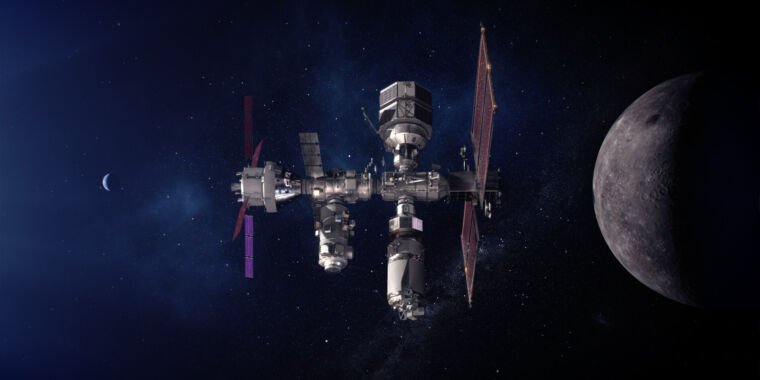
NASA/Alberto Bertolin
Relations between NASA and Russia’s state-owned aerospace company were quite robust five years ago when the two sides signed a joint statement talking about cooperation in the development of a lunar-orbiting space station called the Lunar Gateway. At the time, Russia’s Roscosmos was expected to provide an airlock for the facility.
Of course, a lot has happened in the five years since. In 2020, as NASA began to formulate more concretely its plans for lunar exploration under the Artemis program, Russia began to back out.
“In our opinion, the Lunar Gateway in its current form is too US-oriented, so to speak,” said Roscosmos Director General at the time, Dmitry Rogozin. “Russia is likely to refrain from large-scale participation.” At the time, Rogozin also expressed contempt for the “Artemis Accords” drafted by NASA, which established a set of principles to guide cooperation between countries participating in the agency’s 21st-century lunar exploration plans.
By the time Russia invaded Ukraine in 2022, the country had already focused on collaborating with China on an “international lunar research station.” This is a parallel effort of NASA’s Artemis program, which invites countries to join China and Russia in collaborating on lunar exploration.
As Russia drifted away from NASA, nearly two dozen countries have signed multilateral agreements to join NASA’s Artemis Accords. One of the founding member states, the United Arab Emirates, wants to further expand its participation. On Tuesday, The National reported that the UAE is in talks with NASA to provide an airlock for the Lunar Gateway. The small country in the Middle East has worked with Boeing on designs.
Separately, a source confirmed to Ars that the UAE has been talking to NASA for about a year to create an airlock for the Gateway. The first elements of this small station, which will fly in halo orbit around the moon, are likely to be launched on a Falcon Heavy rocket in late 2024 or 2025. Humans will not live on the Gateway all the time, as they do on the International Space Station. but rather inhabit it periodically. An airlock would make spacewalks easier.
The Islamic nation, which is smaller in area than the US state of Maine, has a population of about 9 million people. However, it has shown an inordinate interest in space exploration. In June 2020, the UAE space program, through a partnership with the University of Colorado Boulder, sent the “Hope” probe to Mars to study the atmosphere of the red planet. UAE officials said the aim of this program was to inspire the younger generation to study science, technology, engineering and medicine. At the time, only Russia, the United States, the European Union and India had successfully launched a spacecraft into orbit around Mars.
Last weekend, the UAE took part in its first lunar launch. His small Rashid lunar rover was a passenger aboard the Hakuto-R lander, which was commercially developed by the Japanese company ispace. That mission successfully launched on a Falcon 9 rocket and is expected to land on the moon early next year.
The country also has a small astronaut corps. In 2019, Hazza Al Mansouri flew as a visiting astronaut on a Soyuz rocket to the International Space Station for eight days. In February, Sultan Al Neyadi will join the Crew-6 mission, where he will spend about six months aboard the space station. His seat was brokered by Axiom Space. Other UAE astronauts are training in Houston for future space missions.
Through its partnership in the Artemis Accords, the UAE is positioning itself to send an astronaut to the Lunar Gateway later this decade — and perhaps to the surface of the moon in the 2030s.

